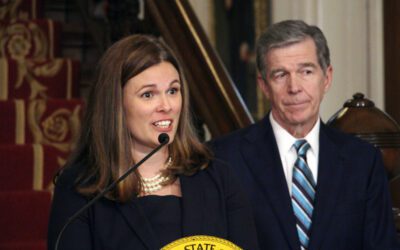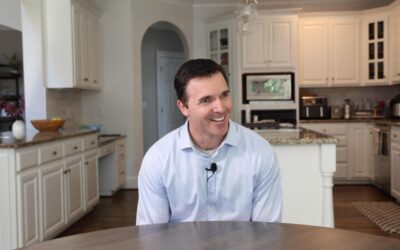
Workers at a Walgreens location in Durham, N.C. assist persons with tests for COVID-19 at a temporary drive-thru site where patients administer their own tests in May 2020. To alleviate long testing lines today amid the Omicron surge, health officials are giving away tests and masks. (AP Photo/Gerry Broome)
Black and Latino North Carolinians have been sickened during the pandemic at alarming rates.
With NC’s Black and Latino population making up a disproportionate number of coronavirus deaths and cases, respectively, the state’s top public health agency says it will launch an initiative dispatching up to 250 public health professionals to historically underserved areas with high COVID-19 caseloads.
These professionals, called “Community Health Workers,” will be tasked with connecting North Carolinians affected by COVID-19 with needed services and support.
As Cardinal & Pine has reported, Black North Carolinians make up for 33% of the state’s confirmed coronavirus deaths, but only about 22% of its population. Meanwhile, Latinos account for a staggering 43% of cases, but less than 10% of the population. And that’s with major gaps in racial and ethnic information for the state’s count. Indeed, the state lacks ethnicity data on more than 36,000 of its confirmed 105,000 cases, about 34% of cases.
“There’s been historical and current experiences of trauma and exploitation and we have to acknowledge those things,” says Winston-Salem sociologist Allison Mathews, from the The Maya Angelou Center for Health Equity, a group that is working to keep the flow of communication open between hospitals and the community.
Mathews says there are several factors that have contributed to spikes in these areas, especially among Black and Latino communities.
Support Needed in Marginalized Communities
The state workers will connect patients with medical and social support resources, the DHHS says, including diagnostic testing, primary care, case management, nutrition assistance and mental health services. The agency will also contract with one or more state-based organizations to recruit, train and manage those workers.
“People dealing with a COVID-19 infection need a complex range of medical and social support, especially if they live in a historically underserved community,” NCDHHS Deputy Secretary E. Benjamin Money, Jr. said in a statement. “By deploying teams of Community Health Workers to the places we know North Carolinians need help, we can address unmet needs while helping to slow the spread of this virus.”
The program will run through December, with the possibility of renewal, officials say.
North Carolina health officials are taking multiple approaches to combating the racial disparities. Some medical centers in the state have already rolled out programs to address spikes in underserved areas.
Atrium Health CEO Eugene Woods, whose network of medical providers serves the Charlotte area, told the US Senate’s Special Committee on Aging Tuesday that they used analytics to pinpoint racial disparities in testing.
“We created a COVID-19 Geographic Information System (GIS) Map, which includes COVID-19 geographical spread and hot spots, as well as geographical testing density, so that we can better understand which communities may be experiencing barriers to testing,” Woods said. “Included in this is the ability to view a variety of social factors such as population density, median income, higher poverty zip codes, the concentration of Blacks or Hispanics geographically, as well as the location of churches, schools and bus routes.”
Distrust of Public Health, Medical Profession Lingers
Between 1933 and 1974, North Carolina ran one of the largest eugenics programs in the country. Eugenics discouraged the reproduction of immigrants, people of color, poor people, unmarried mothers, the disabled and the mentally ill and led to federally-funded sterilization programs throughout the United States. The concept became unpopular due to Adolf Hitler’s support.
In North Carolina, nearly 7,600 men, women, and children were sterilized, the third highest total in the country. While most states slowed down or stopped their programs after World War II, NC ramped up sterilizations, using social workers to refer participants to the North Carolina Eugenics Board while other states left the referral process to doctors working in prisons and mental hospitals. Former Wake Forest University president William Louis Poteat championed the movement long after the general public stopped.
The state has made efforts to compensate victims, but the recency of this and other examples of medical exploitation like the Tuskegee Syphilis Study, have created a chasm between marginalized communities and health professionals, experts say.
Today, institutional barriers such as transportation, access to testing and hospitals, multigenerational households and ability to take time off work contribute to racial disparities in COVID-19 cases and deaths, experts say.
And in the Latino community, advocates say many undocumented immigrants fear that if they access healthcare, they will be reported.
“There are very few protections for undocumented workers and they have skyrocketing rates of COVID-19 infection,” said Mathews. “Also, there are not enough healthcare providers, community health workers, and case managers who can speak Spanish.”
For NC’s Black population, Mathews said her organization is working with a network of 100 Black pastors and their churches for regular coronavirus education programming.
Pastor Mia Sloan of St. Peter’s Church and World Outreach Center in Winston-Salem told Cardinal & Pine about the tedious experience of taking her daughter to drive-thru testing at Duke Urgent Care.
“There were no lines. We were asked to go to the side (without) a lot of information about what we needed to do,” Sloan said. “We were transferred (from person to person) and it was kind of a tail spin that really led nowhere and then we ended up being put on hold for a very long time.”
According to an extensive review of testing sites by FiveThirtyEight, sites in Black and Hispanic communities in many major cities face higher demand than sites in whiter or wealthier areas in those same cities. The review found that testing resources were limited in poorer areas, with fewer sites, located farther away.
Sloan says Black patients also face a more subtle, well-documented, form of discrimination in the doctor’s office.“You almost have to exaggerate symptoms to even be referred for testing,” she says. “As a Black woman, it’s as if your symptoms are diminished.”
Mathews says that transparency and listening will be the key to bridging the gap of trust between these communities and medical professionals.
“(We have to involve) community members in every aspect of the process from the design of the research, to making decisions about where the testing sites go, educating them about coronavirus and educating them about the healthcare system and how to navigate it,” said Mathews.
“(We need to listen) to community members (and) not make decisions about (treatment) without their input and without their knowledge. Because they’re experts in their own lives and their lived experiences matter in the way that we shape the plans for addressing healthcare.”

Op-Ed: Studying the Holocaust remains vital to ensuring it never happens again
International Holocaust Day will be observed on January 27, 2024. This day commemorates the liberation of the Auschwitz concentration camp by the...

VIDEO: How Rural Broadband Is Coming to This North Carolina County
More than 1.1 million North Carolinians lack access to high-speed internet, a necessity of the modern economy. In Warren County, help is on the way,...

VIDEO: Sampson County puts Biden’s promise to boost rural infrastructure to the test
Locals in this rural NC county say their water and air is polluted by a PFAS-contaminated landfill, massive hog and poultry farms, and industrial...

VIDEO: Sampson County puts Biden’s promise to boost rural infrastructure to the test
Locals in this rural NC county say their water and air is polluted by a PFAS-contaminated landfill, massive hog and poultry farms, and industrial...

Mold and classes in trailers: Inadequate funding for schools is hurting NC communities
Schools across the state are dealing with dilapidated classrooms and buildings in need of significant repair or a total rebuild due to a lack of...







